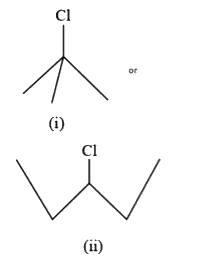Complete Solutions to MULTIPLE CHOICE QUESTIONS of chapter HALOALKANES AND HALOARENES TEST of Class 12 book with complete answers and questions
| Class 12 | CHEMISTRY |
| Chapter | HALOALKANES AND HALOARENES TEST |
| NTA MOCK TESTS | MULTIPLE CHOICE QUESTIONS |
| Number Of Questions | 30 |
| Academic Year | 2023-24 |
An `S_(N)2` reaction at an asymmetric carbon of a compound always gives -
View SolutionWhich one of the following two substances undergoes `S_N1` reaction faster ?

View Solution
Major Product (Z) will be if `Cl_2` is taken in large excess.
View SolutionWhat do you expect to be the main product when tertbutyl bromide reacts in the following manner ?

View SolutionWhat is the major product of the reaction ?

View SolutionChoose the correct statement about the major product formed in `E_2` reaction ?

View SolutionWhich one of the two lodine atoms will be more reactive in the `S_(N)1` and `S_(N)2` reaction ?

View SolutionWhat is the substitution product of the following reaction ?

View SolutionWhat is the major product of the reaction shown ?

View Solution`CH_(3)Br overset(KCN) to A overset(4[H])underset(LiAlH_(4))to CH_(3)CH_(2)NH_(2)`
IUPAC name of A is:
View SolutionWhich of the following would be the best (most reactive) nucleophile in the polar medium ?
View SolutionThe isomer of hexane that gives the minimum and maximum number of monochloro derivatives are respectively
View SolutionOf the five isomeric hexanes, the isomer which can give only two monochlorinated compounds is (excluding stereoisomers)
View SolutionWhich of the following alkane on mixing with chlorine and irradiating the mixture with ultraviolet light, form only one monochloroalkane.
View SolutionIn the reaction sequence,
`C_(2)H_(5)Cl + KCN overset(C_(2)H_(5)OH) to X overset(H_(3)O^(oplus))underset(Delta) to Y`
What is the molecular formula of Y ?
View SolutionWhich halide does not get hydrolysed by sodium hydroxide ?
View SolutionIdentify X and Y in the following sequence:
`C_(2)H_(5)Br overset(X) to "product" overset(Y) to C_(3)H_(7)NH_(2)`
View SolutionIn the following sequence of reactions:
`C_(2)H_(5)Br overset(AgCN) to X overset("Reduction") to Y`, Y is:
View SolutionWhich of the following applies in the reaction,
`CH_(3)CHBrCH_(2)CH_(3) overset("Alc. KOH") to`
(i) `CH_(3)CH = CHCH_(3)` (major product)
(ii) `CH_2 = CHCH_2CH_3` (minor product)
View SolutionThe major product of the following reaction is:

View SolutionOn warming with silver powder, chloroform is converted into:
View SolutionWhen Ethyl chloride and alcoholic KOH are heated, the compound obtained is:
View SolutionWhich of the following will displace the halogen from the solution of the halide ?
View Solution
The major product in the above reaction is:
View SolutionThe organic chloro compound, which shows most readily `S_(N)2` reaction, is:
View Solution`CH_(3)CH_(2)COOH overset(Cl_(2))underset("red P") to A overset("alc KOH") to B`
What is B?
View SolutionThe `S_(N)2` reaction involves back-side attack and therefore results in a "Walden Inversion." For which one of the substrates shown would you be able to demonstrate that such back-side attack with "Walden Inversion" has in fact occurred ?
View Solution2, 2-dimethyl-1-chloropropane undergo nucleophilic substitution reaction to produce an optically inactive product which of the following is correct regarding the product ?
(i) Formation of product takes place through `SN^(1)` reaction.
(ii) The product is optically inactive due to internal compensation.
(iii) The product is optically inactive due to external compensation.
(iv) The carbocation is not an intermediate in the given reaction.
Choose the correct option.
View SolutionIn the nucleophilic substitution reactions (`S_N2` or `S_(N)1`) the reactivity of alkyl halides follows the sequence.
View SolutionThe order of reactivities of methyl halides in the formation of Grignard reagent is,
View Solution
MULTIPLE CHOICE QUESTIONS questions and complete solutions for chapter HALOALKANES AND HALOARENES TEST of NTA MOCK TESTS of Class 12